 |
|

|
 |
TABLE of CONTENTS
 |
New federal transportation bill provides $4 billion, stability for Minnesota |
By Chris Joyce
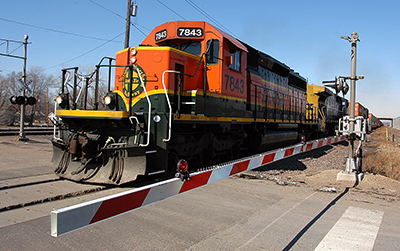
FAST authorizes $10.3 billion for rail programs, the first surface transportation act to include such authorization. Photo by David Gonzalez |
With the passage of a five-year federal transportation bill earlier this month, MnDOT has four billion reasons to be happy—one for each dollar Minnesota receives under the new Fixing America’s Surface Transportation Act.
FAST, whose predecessors include MAP-21, SAFETEA-LU and ISTEA, reauthorizes federal highway and public transportation programs for 2016-2020. It also stabilizes the Highway Trust Fund during that period; however, those funds will be used up by the end of 2020, and will require a legislative solution to prevent the fund’s insolvency.
“This is a modest, but crucial, increase that provides some stability over the next five years,” said Serge Phillips, federal relations manager. “It helps our planning efforts knowing that we can count on receiving a certain amount of federal money each year.”
Highlights for Minnesota in the new 1,300-page transportation bill include:
- Highways – Increases highway funding by 5 percent in FY 2016, and by 2 to 2.5 percent per year in the remaining years. The levels exceed projected inflation by $1.7 billion over five years. For Minnesota, that means going from receiving $629 million in FY 2015 to $722 million in FY 2020.
- Funds two new programs: A formula national freight program (Minnesota gets $104 million over five years) and a Nationally Significant Freight and Highway Projects competitive grant program ($4.5 billion available nationally over four years).
- Ends the ability of states to shift highway safety dollars designated for safety projects to behavioral or educational activities. In the past, Minnesota has used this shift to fund Toward Zero Death initiatives, so this new provision amounts to a loss of funding for MnDOT.
- Provides two truck size/weight exemptions that affect Minnesota: (1) Logging vehicles weighing up to 99,000 pounds can use Interstate 35 from Cloquet north, which is an exemption from the national truck size/truck weight limits of 80,000 pounds; (2) Vehicles carrying milk products are now considered to be carrying a divisible load, allowing them to carry weights higher than the 80,000-pound limit.
- Mass transit – Increases public transportation investment by 5 percent in FY 2016, followed by annual increases of 1.6 percent during the next four years. The levels exceed projected inflation by $700 million over the next five years.
- New rail title – FAST is the first surface transportation act that includes authorization for rail programs. There is $10.3 billion for rail provisions (subject to annual appropriation) with 50 percent of that amount for national state supported passenger rail.

Serge Phillips, federal relations manager, is MnDOT’s liaison with Minnesota’s congressional delegation. Photo by Rich Kemp |
Among other provisions, Minnesota received increased funding that will allow mass transit system providers in Greater Minnesota to buy more buses and bus facilities.
“We appreciate Minnesota’s congressional delegation for coming up with a solution to help push this five-year funding bill through. It’s our responsibility now to put the resources to the most efficient use for the state,” said Phillips.
Despite the new federal funding bill, Minnesota still faces a projected funding shortfall of $16.3 billion over the next decade to provide a transportation system that addresses infrastructure needs and congestion issues, and supports Minnesota businesses.
“To meet the need, we all have to work together—local, state and federal,” said Commissioner Charlie Zelle. “The federal government has done its part and local governments are also developing funding strategies. Now, it is up to the state Legislature to do its share.”
|
 |
|

|
 |
TABLE of CONTENTS
 |
MnDOT takes new twist on public engagement |
By Sue Roe
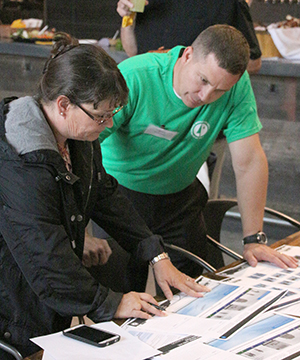
Jon Solberg, Metro District South Area engineer, talks with a stakeholder about a bridge project planned for 2018. The workshop was held at a local brewery as a way to engage stakeholders who may not otherwise attend more traditional public meetings. Photo courtesy of Metro District |
When projects and plans are first proposed, MnDOT meets legal and regulatory requirements to get citizen comments by hosting open houses and public hearings.
But these days, MnDOT is trying more innovative and creative ways to effectively reach stakeholders in hopes of turning an often unengaged public into an engaged one.
”We realize we have to go to where people are to better connect,” said Philip Schaffner, policy planning director in the Office of Transportation System Management. “We understand that most people don’t go to public meetings unless it affects them directly, such as the road in front of their house.”
Listening to customers and getting the message out often in a variety of ways is exactly what the Office of Customer Relations found that the public wants.
The office directs market research, including online community surveys indicating that current messaging tactics and frequency aren’t always meeting the broader public’s needs of getting informed about projects.
“It’s no secret people don’t consider open houses convenient, but they do want the information we provide and an opportunity to give input,” said Karla Rains, Customer Relations director. “People are busy and that’s what they’re telling us, but their busy lives don’t negate their interest.”
Customer Relations conducted a survey of 400 online customers in fall 2015. It sparked MnDOT to officially rethink its public engagement efforts. Also driving the effort was the new Governor’s Diversity and Inclusion Council, on which Commissioner Charlie Zelle serves. One of the council’s goals is to actively engage diverse communities in developing state policies.
Going to where stakeholders are
Schaffner said open houses, stakeholder forums and public hearings still work for the more traditional groups such as government and advocacy groups, but for underserved populations and the general public, planners and others who need to get public opinions are increasingly trying new ways to reach out.
The state fair is a recent example of OTSM’s outreach techniques. Planners engaged more than 5,500 fairgoers by having them place stickers about transportation priorities on posters at the MnDOT booth. The information is being used to update the Statewide Multimodal Transportation Plan and the 20-Year State Highway Investment Plan.
Planners also attended the Minneapolis Zombie Pub Crawl in fall 2015 to get comments. Armed with iPads, they “worked the line” to ask people, dressed as zombies waiting to get into the event, to fill out surveys about transportation.
“People were interested in talking with us,” said Schaffner. “We had a captive audience since they were standing in line. Although the event was in downtown Minneapolis, they were from all over the state.”
Planners also went to the Mankato Marathon, the Burnsville Halloween Fest, the Anoka Halloween Parade and other community events. Planners are also giving presentations at work places.
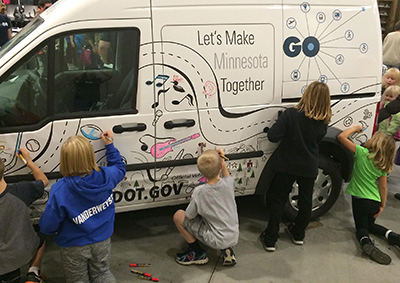
Children color the new Minnesota GoMobile at the Made in Minnesota Expo in St. Cloud. As the children colored, parents filled out online and paper surveys about transportation. When not in use at public engagement events, the van is also used to deliver MnDOT mail. Adam Oie, graphic designer in Communications, designed the van. Photo by Josh Pearson |
At the Made in Minnesota Expo in St. Cloud in November, the “Minnesota GoMobile” debuted. People can color on the design of the van, sparking interest and conversation.
“We want to focus on going to the public and stakeholder groups early and often,” said Schaffner.
New techniques reach more people
Project teams are also using social media and online surveys. One survey, called mentimeter voting, allows people to vote on questions by entering a code into their cellphones.
In Mankato in 2012, two years before a roundabout construction project began, District 7 staff used toy cars to show drivers how to navigate multi-lane roundabouts during the Mankato Senior Expo. Staff returned to the Expo in 2013 and 2014 and used a roundabout mat, an exact replica of one of the built roundabouts, so people could walk on it to understand how to maneuver a roundabout in their vehicle. After the first roundabout was built in Mankato, more than 500 people attended the “roundabout fair” to ride or drive golf carts through it.
More than 70 percent of people polled at the 2012 Expo said they hated roundabouts. After two years of public engagement, 70 percent said they liked the roundabouts.
“We really tried to reach everyone we could with a variety of techniques from brochures and videos to more creative walkable rugs, tours and hands-on driving experiences,” said Greg Ous, District 7 engineer.
For a Metro District bridge project, planned for 2018, MnDOT held workshops at a brewery, a café and a locally owned Mexican restaurant. A bridge inspection video posted on Facebook helped build interest.
To ease the disruption to 100 businesses during the Snelling Avenue project in St. Paul, Metro District public affairs staff built relationships by walking door to door to talk with business owners.
MnDOT and supporting neighborhood partners celebrated the project’s completion with walking tours, offering food from local restaurants, music and kids’ activities.
MnDOT formed a statewide public engagement implementation team to encourage and find ways to support enhanced engagement. Four focus areas were set, including forming a new public engagement policy, developing resource materials and creating measures and an external advisory team to review and guide MnDOT’s efforts. This work is informing the development of MnDOT’s Statewide Public Engagement Policy, scheduled for roll out in March 2016.
Rains said the policy will provide clarity, identify roles and provide public engagement guidance and practices. A new iHUB page will be created as a one-stop shop and to share successes across the agency.
In the end, Rains said an engaged and informed public helps MnDOT address the complex transportation challenges affecting travelers and communities. |
 |
|

|
 |
TABLE of CONTENTS
 |
Commissioner exchanges flags with tribal nations |
|
By Cynthia Bellefeuille, Government Affairs
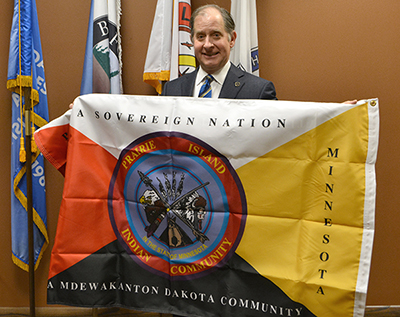
Commissioner Charlie Zelle holds the Prairie Island Indian Community tribal flag, part of a flag exchange program with the Minnesota Indian tribes. Photo by Rich Kemp |
Commissioner Charlie Zelle is working with tribal governments in Minnesota on a government-to-government basis, as part of Gov. Mark Dayton’s Executive Order 13-10.
Through formal meetings with tribal governments, and during the Tribal-State Relations Training, Zelle exchanges a Minnesota State flag for a flag from the respective tribal nation. The ceremonial exchange acknowledges the unique legal and political relationship with Indian tribes and serves as a reminder of the special sovereign status Minnesota tribes have with federal and state governments.
The concept for adding each of the tribal nation’s flags originated from feedback out of the government-to-government Tribal State Relations Training. As a result, Edward Fairbanks, tribal liaison, brought the idea to Sue Mulvihill, deputy commissioner, about a possible traditional exchange of flags between tribal government leaders and Zelle.
Since the Minnesota tribal nations' flags are only available from their respective tribal governments, Zelle presented a Minnesota state flag in exchange as a symbol of mutual respect and commitment to government-to-government relations.
MnDOT’s goal is to fly all 12 tribal nations flags at Central Office as an affirmation of respect for its working relationship with all of Minnesota. |
 |
|

|
 |
TABLE of CONTENTS
 |
Crew installs rumble strips along highways in southwest Minnesota |
|
Newsline followed a crew in District 8 as they installed rumble strips along Hwy 12 in October. MnDOT is installing centerline and shoulder rumbles to alert inattentive or drowsy motorists whose vehicles have drifted out of their travel lane. Video produced by Rich Kemp |
|
 |
|

|
 |
TABLE of CONTENTS
 |
Favorable weather brings longer than average shipping season on Mississippi |
By Marcia Lochner, Office of Freight and Commercial Vehicle Operations
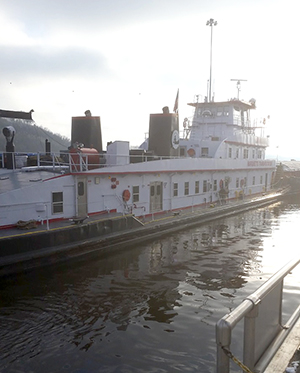
Motor vessel Charlie G. heads south out of Lock and Dam 2, near Hastings on Dec. 3. Photo courtesy of U.S. Army Corps of Engineers |
Motor vessel Charlie G. marked the unofficial end of the Mississippi River shipping season Dec. 3 when it pushed 12 barges south through Lock and Dam 2 near Hastings.
“It was a great year for navigation,” said Jim Rand, St. Paul District locks and dams chief. “We saw a slight increase in the annual tonnage with an estimated 96.7 million tons of commodities being shipped within the St. Paul District.”
The U.S. Army Corps of Engineers’ St. Paul District area includes most of Minnesota, the western half of Wisconsin, the northeastern half of North Dakota and small portions of South Dakota and northern Iowa.
The weather plays a significant role in the duration of the shipping season, whether it's early ice in the fall, late thaw in the spring, or high and low water levels throughout the season. Favorable weather conditions contributed to this season lasting 254 days, longer than the average length of 250 days.
The 2015 season started March 25.
“Unlike the 2014 river shipping season, which was littered with high water events and dredging crises, Mother Nature cooperated in 2015, causing no significant slowdowns to barge traffic in Minnesota,” said Patrick Phenow, Ports and Waterways program coordinator.
The Mississippi River system stretches more than 222 miles in Minnesota and supports five port areas providing essential transportation connections and access to national and international markets. Agricultural products such as corn, soybeans and wheat are the state’s largest river tonnage commodities and the Mississippi River accounts for more than 50 percent of Minnesota’s agricultural exports.
“Operationally, 2015 was a good season at this end of the river,” said Lee Nelson, president of Upper River Services, a full service river operation on the Mississippi River in St. Paul. “With Minnesota’s record grain harvest this year, we’re expecting the first quarter of 2016 to be even better for grain loading.”
To learn more, visit MnDOT’s Ports and Waterways website. |
 |
|

|
 |
TABLE of CONTENTS
 |
District 3 mourns loss of Roger Cichon |
By Rich Kemp
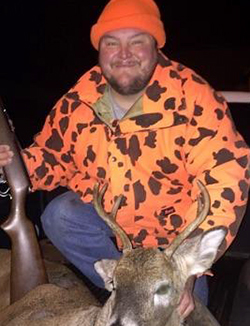
Roger Cichon, Long Prairie truck station, died Dec. 11. Photo courtesy of the Cichon family |
Roger Cichon, District 3 maintenance, died of natural causes Friday, Dec. 11, in Swanville. Cichon, 38, worked for MnDOT for 15 years, the last nine at the Long Prairie truck station.
“Roger was a very dedicated employee who always had a smile on his face,” said Todd Fussy, Little Falls maintenance sub area supervisor, District 3. “He was very thorough on his daily job assignments, especially maintaining equipment. He will be greatly missed.”
Cichon started with the Seeds program as a student worker para-professional in the St. Cloud equipment shop in 2001. He moved to the Sauk Centre truck station in 2004 and worked in St. Cloud and Little Falls before moving to Long Prairie in 2006.
He enjoyed working on cars, woodworking, watching movies, deer hunting and playing with his dog, Keylo.
Cichon is survived by his girlfriend, Tina Malone; sister Kathy; and brothers, Jim and David.
Mass of Christian Burial was held Dec. 19 in Swanville.
|
 |
|

|
 |
TABLE of CONTENTS
 |
Cyber security is important at work and home |
By Bill Leifheit, information security officer
Editor’s note: This is the final article in a four-part series on cyber security tips.
Holiday phishing scams
It’s easy to do your shopping over the Internet, but it pays to remain vigilant when browsing or shopping online this holiday season. The Internet is also convenient for attackers, giving them multiple ways to access the personal and financial information of unsuspecting shoppers.
How can you protect yourself?
- Do business with reputable companies – Before providing any personal or financial information, make sure that you are interacting with a reputable, established vendor.
- Make sure your information is encrypted – Many sites use encryption to protect your information. Indications that your information will be encrypted include a URL that begins with "https:" instead of "http:" and a padlock icon.
- Use a credit card – There are laws to limit your liability for fraudulent credit card charges, but you may not have the same level of protection for debit cards.
- Check your statements – Keep a record of your purchases and copies of confirmation pages, and compare them to your bank statements. If there is a discrepancy, report it immediately.
Have a safe and happy holiday season!
For previous articles in the series, see
|
 |
|

|
 |
TABLE of CONTENTS
 |
What’s new on the web |
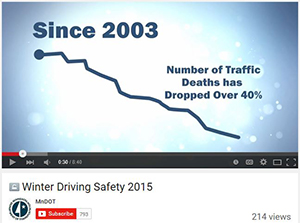
One of the three new safety videos on the Work Zone Safety Awareness website focuses on safely driving near and around snowplow operations and how to drive in winter conditions. Video produced by Video Services |
Work Zone Safety videos
Check out three new safety videos on the Work Zone Safety Awareness website. Two videos will help drivers navigate the different work zones throughout the state during the winter and summer seasons. A third video will help motorists understand the zipper merge, flashing arrow signals and Rural Intersection Conflict Warning systems. These and other videos are also available on MnDOT’s YouTube channel.
New Library Materials posted on the web
New Library Materials are available at www.mndot.gov/library/newlibmat.html. This issue includes MnDOT Library highlights of 2015 and holiday greetings from the Library staff with a slideshow.
New Library Materials is a compilation of new titles and other resources added to the library collection during the previous month. To be added to the distribution list, contact pamela.m.gonzalez@state.mn.us or 651-366-3749.
Previous editions of New Library Materials are archived and available at www.dot.state.mn.us/library/recacq-archive.html. For other information requests, contact the Library at 651-366-3791 or e-mail library.dot@state.mn.us, or send requests via the Ask a Librarian web page. |
 |
|

|
 |
TABLE of CONTENTS
 |
Minnesota Rail Service Improvement program is lifeline for state’s short line railroads |
By Marcia Lochner, Office of Freight and Commercial Vehicle Operations
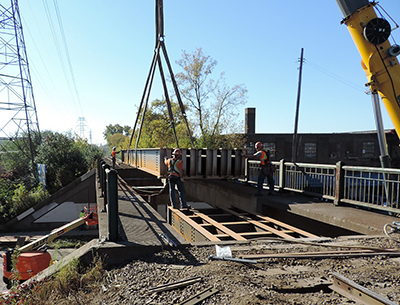
A new steel bridge deck is lifted into place on Minnesota Commercial Railroad’s bridge over Como Avenue in St. Paul. Photo courtesy of Minnesota Commercial Railroad |
People may be familiar with a “short line” railroad if they’ve ever played Monopoly, but what might not be known is that Minnesota has 14 of these class III railroads operating throughout the state. They transport many of the daily essentials, from grains for food products to fuel for transportation. Minnesota’s short line railroads are small independent railroad companies that operate over relatively short distances on lower density rail lines, feeding traffic into and from mainline railways. These railroads provide vital transport services to the state’s regional and rural markets and are critical to economic development in these areas.
Some of Minnesota’s short line and regional railroads need improvements and rehabilitation to continue providing competitive options and efficient movement of goods for shippers. Additionally, shippers need access to capital to construct facilities that allow them to ship products by rail. To assist with financing these rail improvements, MnDOT administers low- or no-interest loans through the Minnesota Rail Service Improvement program. Without this assistance, some of these railroads and facilities might deteriorate or be abandoned. This would force shippers to either truck all of their freight, which is less efficient and increases highway congestion, to go out of business or relocate.
“This type of financing is crucial to many of the businesses in the state that depend on rail transportation,” said Peter Dahlberg, program manager in the Office of Freight and Commercial Vehicle Operations. “Many times small railroads and businesses lack the upfront capital to make necessary improvements on their own.”
Funding for this loan program comes from the Legislature, either from general funds or bonds that can assist with short line rail improvements. The last time funding was provided to the overall MRSI program was in 2010, when the Legislature provided $2 million in general obligation bonds. As loan repayments are made toward outstanding loans, those dollars go back into the program funds and can be applied toward new loans.
The program has funded nine projects across the state since 2010. It has administered more than $57 million in loans for capital improvement projects and completed 103 of these projects since 2000.
This past October, Minnesota Commercial Railroad received assistance from MRSI to replace the corroded steel bridge deck over Como Avenue between St. Paul and Lauderdale. This is a vital mainline track for this small short line railroad that connects many shippers in the north Twin Cities metro with a national rail system. The expensive cost to repair this deteriorating bridge was a major issue needing an immediate fix. The railroad worked with MnDOT to get a loan through the MRSI program to make the repairs. While that benefits their customers who are businesses in the area, it also keeps the road safe for the people traveling underneath.
“The MRSI program is unique because railroads and their customers are generally private businesses and this is one way that MnDOT can help small businesses in the state have better access to the worldwide economy,” said Dahlberg.
Visit MRSI for more information. |
 |
|

|
|

|
 |
TABLE of CONTENTS
 |
Donated vacation hours help Metro District employee through life-threatening illness |
By Kevin Walker, Metro District public affairs coordinator

Kevin Walker, Metro District public affairs coordinator, participated in the state vacation donation program in 2014.
Photo by David Gonzalez |
I became eligible for the state’s vacation program in January 2014. After numerous surgeries, and also acquiring a hospital superbug that manifested as a life-threatening blood infection, I had exhausted my sick leave and my vacation leave during my medical ordeal. The vacation donation program allowed me to remain on the department’s payroll and maintain my insurance coverage for an additional six months.
Vacation donation hours from my friends and colleagues at MnDOT, in additional to the hours contributed by many anonymous state employees, were extremely helpful to me during this difficult time in my life. The generous gift of donating vacation time to help someone in need was so powerful and supportive during my medical recovery.
The beauty of the state’s vacation donation program is the gift of giving and how we can help others when they are ill, or when they are the primary care giver for a gravely ill family member, and they have exhausted their sick leave and vacation leave during a medical emergency.
Anyone can be faced with a medical challenge in their life that they were not expecting, and to be able to help others during such a difficult time is greatly appreciated by the recipients.
It is the holiday season and the time for giving. If you find yourself with a little extra time in vacation bank, the Vacation Donation program is truly a worthwhile gift to make. Consider paying it forward now to a friend, or state colleague, in need.
In my situation, I feel fortunate to be back at work full time since May 2015. I would like to thank everyone who donated their vacation time to me. Thank you for your support and kindness during my medical journey. I am so proud to be part of the MnDOT organization.
Editor’s note: The state vacation donation program allows employees to donate up to 40 hours of vacation per fiscal year for approved recipients who have exhausted their sick and vacation leave due to illness.
To donate vacation hours, go to the Employee Self Service Website and click “Other Payroll” and then “Leave Donations.” The site also allows employees to view a list of all state employees eligible for the program and enroll as a recipient.
Vacation donation requests
MnDOT employees currently eligible for the state’s vacation donation program areSusanne Herberg, account clerk senior in District 2 payroll; Kent Uecker, transportation generalist in the Metro Distict; Paul Sargent, Support Services Section at Central Office; Wayne (Toby) Tennison, Metro District training department; and Thomas Brown, District 2 transportation generalist.
Check out a vacation donation article in the Nov. 10 edition of Newsline that covers the requests for Herberg, Uecker, Sargent, Tennison and Brown.
Employees may donate up to 40 hours of vacation per fiscal year; however, donations in any amount will be helpful. Hours donated are not considered taxable income for the donor nor are they considered tax-deductible expenses.
To donate, please:
• Log into the State Employee Self-Service website: (https://portal.s4web.state.mn.us/psp/por91ssap/SELFSERVICE/ENTP/h/?tab=MN_GUEST
• Click on “Other Payroll.”
• Click on “Leave donations.”
• Click on “Input Your Leave Donations,”
• Click on the magnifying glass next to “Reserve Bank” to open a list of names.
• Choose the employee’s name you would like to donate to.
• Enter the number of hours that you wish to donate.
• Click on the yellow “Save” box.
A paper form is also available online to donate to an employee on the Vacation Donation Program.
|
|
 |
|
| |
|



